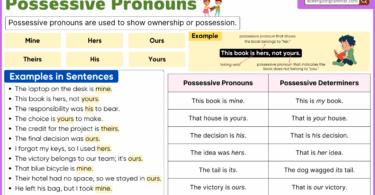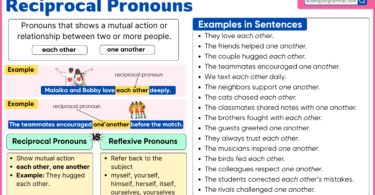Nouns are words that name people, places, things, and ideas. They can be singular or plural, depending on whether they refer to one or more than one. A singular noun refers to one person, place, thing, or idea, while a plural noun indicates more than one. It’s as simple as adding an -s or -es to the end of a word in most cases. In this article, we’ll explore the world of singular and plural nouns in detail, providing more examples and exercises to help you understand this important grammatical concept. So let’s get started!
Table of Contents
What is a singular noun?
A singular noun is a single, individual word that represents one person, place, thing, or idea. It refers to just one of something rather than multiple ones. For example, “dog” is a singular noun because it represents a single dog, not multiple dogs. Similarly, “book” is a singular noun referring to one book, not several books. You can easily spot a singular noun by looking at the article that comes before it. Articles like “a” or “an” are often used with singular nouns. For instance, “a cat” or “an idea.” In contrast, if you were talking about more than one, you would use plural nouns, such as “cats” or “ideas.”
Examples:
- People: boys, girls, teachers
- Places: schools, parks, houses
- Things: books, cars, tables
- Ideas: happiness, courage, ideas
What is a plural noun?
A plural noun is a word that represents more than one person, place, thing, or idea. It’s like having more than a single entity of something. For example, “dogs” is the plural form of the singular noun “dog,” indicating more than one dog. Plural nouns help us talk about groups, collections, or multiples of items. To form a plural noun, we often add “-s” or “-es” to the singular form. For instance, “cat” becomes “cats,” and “box” becomes “boxes.” However, some plural nouns follow different rules, like changing the spelling or not changing at all, such as “child” to “children” and “deer” to “deer.”
Examples:
- dog → dogs
- cat → cats
- man → men
- city → cities
- friend → friends
Rules:
Forming plural nouns in English generally follows specific rules, though there are some exceptions. Here are the primary rules for creating plural nouns:
- Adding “-s”:
- Most singular nouns become plural by adding “-s.”
- Examples: cat → cats, dog → dogs, book → books
- Adding “-es”:
- When a singular noun ends in s, x, z, ch, or sh, we add “-es” to make it plural.
- Examples: box → boxes, buzz → buzzes, church → churches
- Changing “-y” to “-ies”:
- If a singular noun ends in a consonant followed by a “y,” change the “y” to “ies” to make it plural.
- Examples: city → cities, baby → babies
Irregular Plurals:
- Some nouns don’t follow the typical rules and have irregular plural forms.
- Examples: man → men, woman → women, child → children
- No Change:
- Some nouns don’t change at all in their plural form.
- Examples: deer → deer, sheep → sheep, fish → fish
- Collective Nouns:
- Collective nouns refer to groups of people or things. They can be singular or plural based on context.
- Examples: The team is practicing. (Singular) The team are wearing their jerseys. (Plural)
- Nouns Ending in “-s”:
- Some nouns are the same in both singular and plural forms.
- Examples: species, series, means
- Compound Nouns:
- Compound nouns, made by combining two words, can follow the usual rules for plurals.
- Examples: toothbrush → toothbrushes, greenhouse → greenhouses
- Numbers as Nouns:
- When a number is used as a noun, add an “-s” to make it plural.
- Example: I have two cats. (Singular) I have twenty cats. (Plural)
- Nouns Ending in -f or -fe:
- Nouns ending in -f or -fe usually change the -f to -ves in the plural.
- Example: “leaf” becomes “leaves” and “wolf” becomes “wolves.”
Remember that while these rules cover many cases, there are exceptions and irregularities in the English language.
Exceptional cases:
In English, while there are general rules for forming singular and plural nouns, there are also some exceptions and irregularities that don’t follow these rules. Here are some exceptional cases:
Irregular Plurals: Some nouns have irregular plural forms that do not follow the standard rules.
For example:
- Man → Men
- Woman → Women
- Child → Children
- Tooth → Teeth
- Goose → Geese
No Change Plurals: Certain nouns have the same form in both singular and plural. Examples include:
- Deer (one deer, two deer)
- Sheep (one sheep, two sheep)
- Fish (one fish, two fish or more commonly, one fish, two fishes)
Foreign Borrowings: Some words borrowed from other languages maintain their original plural forms. For instance:
- Curriculum → Curricula
- Datum → Data
- Medium → Media
Words Ending in -s: Some words ending in -s do not change in the plural form. For example:
- Series (one series, two series)
- Species (one species, two species)
Collective Nouns: Collective nouns, which represent a group, may take either a singular or plural verb form depending on the context. For example:
- The team is playing well. (Singular)
- The team are all wearing new uniforms. (Plural)
Types of Singular & Plural Nouns:
In English, singular and plural nouns can be categorized into various types based on their form and usage. Here are some common types:
Types of Singular Nouns:
- Basic Singular Nouns: These are standard nouns representing one person, place, thing, or idea.
- Example: Cat, Book, House
- Proper Nouns: Names of specific individuals, places, or things.
- Example: John, Paris, Mount Everest
- Mass: Nouns that represent a substance, concept, or idea that is not easily quantified.
- Example: Water, Happiness, Knowledge
- Gerunds: Verbs ending in -ing that function as nouns.
- Example: Swimming, Reading, Writing
Types of Plural Nouns:
- Regular Plural Nouns: Nouns that follow the standard rules and add “s” or “es” to form the plural.
- Example: Dogs, Books, Houses
- Irregular Plural Nouns: Nouns that do not follow the standard rules and have unique plural forms.
- Example: Men (singular: Man), Children (singular: Child)
- Collective Nouns: Nouns that represent a group of people or things.
- Example: Team, Family, Committee
- Compound Nouns: Nouns formed by combining two or more words.
- Example: Toothbrush, Classroom, Swimming pool.
List of Singular Noun
- Cat
- Dog
- Book
- Chair
- Table
- Car
- Friend
- Tree
- Flower
- River
- Mountain
- Sun
- Moon
- Star
- Computer
- Phone
- House
- City
- Country
- Child
- Adult
- Student
- Teacher
- Doctor
- Elephant
- Lion
- Tiger
- Giraffe
- Butterfly
- Fish
- Bird
- Plane
- Boat
- Train
- Bike
- Piano
- Guitar
- Ball
- Hat
- Shirt
- Pants
- Shoe
- Ocean
- Beach
- Sunflower
- Cloud
- Rainbow
- Butterfly
- Bee
- Elephant
List of Plural Noun
- Cats
- Dogs
- Houses
- Cars
- Books
- Friends
- Computers
- Teachers
- Students
- Rivers
- Oceans
- Mountains
- Cities
- Countries
- Families
- Toys
- Birds
- Fish
- Cakes
- Shoes
- Chairs
- Tables
- Plates
- Keys
- Windows
- Doors
- Gardens
- Flowers
- Trees
- Stars
- Planets
- Languages
- Jobs
- Dreams
- Balloons
- Clouds
- Pencils
- Pens
- Elephants
- Tigers
- Zebras
- Horses
- Cows
- Sheep
- Goats
- Chickens
- Ducks
- Puppies
- Kittens
- Children
- Women
- Men
- People
- Doctors
- Artists
Example Sentences
- Singular: I have a book in my bag.
- Plural: I have two books in my bag.
- Singular: The flower looks beautiful.
- Plural: The flowers look beautiful.
- Singular: A child is playing in the park.
- Plural: Children are playing in the park.
- Singular: The house is painted blue.
- Plural: The houses are painted blue.
- Singular: My friend is coming over.
- Plural: My friends are coming over.
- Singular: The car is parked in the driveway.
- Plural: The cars are parked in the driveway.
- Singular: I saw a bird in the tree.
- Plural: I saw birds in the trees.
- Singular: The computer is on the desk.
- Plural: The computers are on the desks.
- Singular: An apple fell from the tree.
- Plural: Apples fell from the trees.
Singular Noun vs Plural Noun
| Aspect | Singular Noun | Plural Noun |
|---|---|---|
| Definition | Refers to one person, thing, or idea. | Refers to more than one person, things, or ideas. |
| Formation | Simplest form | Formation varies; may involve adding “es,” changing vowels, or using irregular forms (child → children). |
| Examples | Cat, book, friend | Cats, books, friends |
| Subject-Verb Agreement | Requires a singular verb. | Requires a plural verb. |
| Use in Sentences | The flower looks beautiful. | The flowers look beautiful. |
| Quantity | Represents a single entity. | Represents multiple entities. |
| Common Indicators | “A,” “an,” “this,” “that.” | “Some,” “many,” “these,” “those.” |
Singular and Plural Noun Exercises
Choose the correct form (singular or plural) of the noun in each sentence.
- The __________ (child/children) is playing in the park.
- I have two __________ (cat/cats) at home.
- The __________ (mouse/mice) ran across the kitchen floor.
- We bought three __________ (box/boxes) of chocolates for the party.
- My sister has a beautiful __________ (flower/flowers) garden.
- The __________ (man/men) are working hard to complete the project.
- Can you pass me the __________ (knife/knives) from the kitchen?
- I saw a group of __________ (deer/deers) in the forest.
- She has a collection of antique __________ (book/books) on the shelf.
- The __________ (wolf/wolves) howled at the full moon.
Answers:
- child
- cats
- mouse
- boxes
- flower
- men
- knives
- deer
- books
- wolves
FAQs:
Q1. What is a singular noun?
A singular noun refers to a single person, place, thing, or idea. It is the basic form of a noun before any changes to indicate quantity.
Q2. What is a plural noun?
A plural noun refers to more than one person, place, thing, or idea. Pluralization often involves adding “s” or “es” to the singular form, but irregular plurals exist.
Q3. How do you form the plural of most nouns?
For most nouns, you can form the plural by adding “s” to the singular form. For example, “book” becomes “books,” and “dog” becomes “dogs.”
Q4. Are there irregular plural nouns?
Yes, some nouns have irregular plural forms. For example, “child” becomes “children,” and “man” becomes “men.” Learning these irregular forms is important for correct usage.
Q5. How do collective nouns affect verb agreement?
Collective nouns can take singular or plural verbs, depending on the intended meaning. If the emphasis is on the group as a single entity, use a singular verb (e.g., “The team is winning”). If the emphasis is on individual members, use a plural verb (e.g., “The team are celebrating their victories”).
Q6. Give some example sentences of singular and plural names.
Here are some example sentences:
- Singular: I have a book in my bag.
- Plural: I have two books in my bag.
- Singular: The flower looks beautiful.
- Plural: The flowers look beautiful.
- Singular: A child is playing in the park.
- Plural: Children are playing in the park.




Leave a Comment